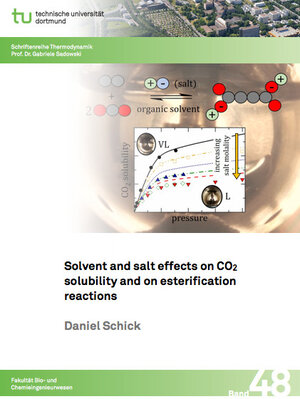
×
![Buchcover ISBN 9783843953610]()
Solvent and salt effects on CO2 solubility and on esterification reactions
von Daniel SchickWidely discussed and recently developed carbon capture and utilization or storage (CCUS) processes deal with the reduction of carbon dioxide (CO2) emissions. Therein, commonly applied reactions often contain additional components, such as gases, solvents, or salts.
In this work, the solvent and salt effects on CO2 solubility and on esterification reactions were investigated. Regarding CO2 solubility, broad ranges of temperatures, pressures, and high concentrations of electrolytes were considered, and solvent effects, salt effects, and pH effects were studied. The nature of the considered systems required including dissociation reactions of carbonic acid in the modeling framework, most importantly for the systems containing carbonate salts. The results showed that i) CO2 solubility was the highest in aprotic-polar solvents, ii) all salts caused salting-out effects on CO2 solubility except carbonates (salting-in due to a pH shift), and that iii) the strength of salting-out effect was related to the charge density of the ions. Moreover, the salt solubility in organic solvents was studied. Therein, solvent-specific analysis and ion-specific analysis revealed a non-intuitive behavior. In contrast to aqueous solutions, salt solubility in organic solvents does not depend linearly on the cation size. Thus, experimental rules of thumb cannot be applied, and the experimental effort can only be significantly reduced by theoretical approaches such as ePC-SAFT. Finally, the knowledge was transferred to investigate the solvent and salt effects on esterification reactions. Therein, a thermodynamic activity-based kinetic approach was applied to predict the solvent influence and salt influence on kinetics and equilibrium.
In conclusion, the importance of a robust thermodynamic modeling framework was highlighted in this work, which ultimately allows reducing the experimental effort toward desired reaction conditions.
In this work, the solvent and salt effects on CO2 solubility and on esterification reactions were investigated. Regarding CO2 solubility, broad ranges of temperatures, pressures, and high concentrations of electrolytes were considered, and solvent effects, salt effects, and pH effects were studied. The nature of the considered systems required including dissociation reactions of carbonic acid in the modeling framework, most importantly for the systems containing carbonate salts. The results showed that i) CO2 solubility was the highest in aprotic-polar solvents, ii) all salts caused salting-out effects on CO2 solubility except carbonates (salting-in due to a pH shift), and that iii) the strength of salting-out effect was related to the charge density of the ions. Moreover, the salt solubility in organic solvents was studied. Therein, solvent-specific analysis and ion-specific analysis revealed a non-intuitive behavior. In contrast to aqueous solutions, salt solubility in organic solvents does not depend linearly on the cation size. Thus, experimental rules of thumb cannot be applied, and the experimental effort can only be significantly reduced by theoretical approaches such as ePC-SAFT. Finally, the knowledge was transferred to investigate the solvent and salt effects on esterification reactions. Therein, a thermodynamic activity-based kinetic approach was applied to predict the solvent influence and salt influence on kinetics and equilibrium.
In conclusion, the importance of a robust thermodynamic modeling framework was highlighted in this work, which ultimately allows reducing the experimental effort toward desired reaction conditions.


